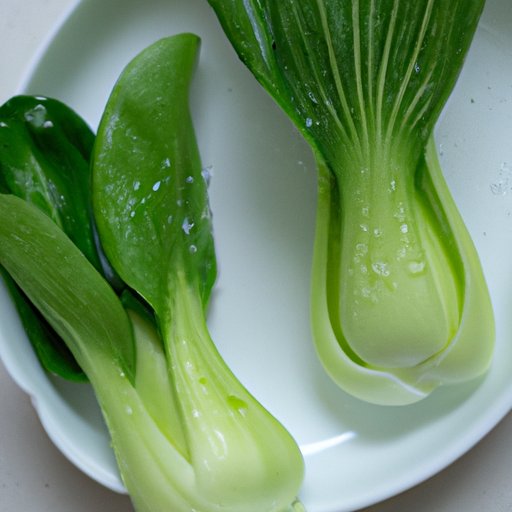
Introduction
Bok choy is a popular ingredient in many Asian dishes. While it’s a versatile ingredient, many people may not know which part of the bok choy is edible, leading to confusion when cooking. This article aims to be an ultimate guide to eating bok choy, from its nutritional value and cultural significance to helpful tips on cooking and using every part of the vegetable.
The Ultimate Guide to Eating Bok Choy: Everything You Need to Know
Bok choy, also known as Chinese cabbage or pak choi, belongs to the brassica family and is native to China. Bok choy is an excellent source of vitamins A, C, and K, calcium, and potassium. Eating bok choy has several health benefits, such as reducing inflammation, aiding digestion, and promoting heart health.
Bok choy comes in various shapes and sizes, such as baby bok choy, white-stemmed bok choy, and green-stemmed bok choy. The different varieties have distinct flavors and textures, making them suitable for various dishes.
Bok choy is also deeply rooted in Chinese culture, representing fortune and prosperity. It is often eaten during Chinese New Year, symbolizing wealth and good fortune.
The Beginner’s Guide to Bok Choy: How to Prepare and Serve It
When preparing bok choy, it’s essential to remove any dirt or grit from the leaves’ folds. Rinse the vegetable under cold running water and gently pat dry with a towel. Bok choy should be stored in the refrigerator for up to five days.
There are several ways to cook bok choy, such as steaming, boiling, stir-frying, grilling, or roasting. Bok choy is a versatile ingredient that can be used in soup, salads, stir-fries, and many other dishes.
Seasonings that work well with bok choy include ginger, garlic, soy sauce, sesame oil, and chili flakes. When cooking, it’s essential to add spices gradually and taste as you go to avoid overseasoning the dish.
From Leaf to Stem: Understanding Bok Choy’s Anatomy for Cooking
Bok choy’s anatomy consists of white stalks and green leaves. Both parts are edible and can be used for different dishes.
The leaves are tender and cook quickly, making them suitable for stir-fries, soups, and salads. The stalks are crisp and juicy and can be used in stir-fries and grilled dishes.
When cooking the leaves, it’s essential to remember that they wilt quickly, so they should be added last. The stalks should be cut into even pieces to ensure they cook evenly.
Recipes and Tips for Using Every Part of the Bok Choy
Bok choy is a versatile ingredient that can be used in various dishes, from soups to stir-fries. Here are some recipes that showcase the different parts of bok choy:
- Stir-fried Bok Choy with Garlic and Ginger
- Bok Choy and Mushroom Soup
- Grilled Bok Choy Salad with Soy Sauce Dressing
To make the most of bok choy, it’s important to use both the stalks and leaves. The stalks can be used to add crunch to salads and stir-fries, while the leaves can be used to add flavor and texture to soups and side dishes.
The Versatility of Bok Choy: How to Incorporate It in Different Dishes
Bok choy is a staple ingredient in many Asian cuisines, such as Chinese, Korean, and Japanese. It can be used in various dishes, such as hot pot, dumplings, and ramen.
Bok choy can also be used in non-Asian dishes, such as tacos, wraps, and burgers. Its mild flavor and crunchy texture make it a versatile ingredient suitable for various cuisines.
How to Choose the Best Part of Bok Choy for Your Dish: Leaf, Stalk, or Both?
The part of bok choy to use in a recipe depends on the dish’s texture and flavor requirements. The leaves are tender and cook quickly, while the stalks are crisp and juicy.
If the recipe requires a crunchy texture, the stalks should be used. If the recipe requires a milder flavor, the leaves should be used. Both parts can be used in dishes that require different textures and flavors.
Common Mistakes to Avoid When Cooking Bok Choy’s Different Parts
One common mistake when cooking bok choy is overcooking it, which can make it soggy and enhance its bitterness. Another mistake is neglecting to remove any dirt or grit from the vegetable, leading to an unpleasant texture.
When cooking bok choy, it’s essential to pay attention to the cooking time and ensure that the vegetable is cooked through but still crispy. It’s also important to clean the vegetable thoroughly before cooking to avoid any grittiness.
Conclusion
Bok choy is a delicious and versatile vegetable that can be used in various dishes. Understanding its anatomy, including what part to use, and how to cook it is crucial in making the most of this ingredient. By using this ultimate guide, you can explore the different ways to incorporate bok choy into your cooking and experiment with different recipes.





